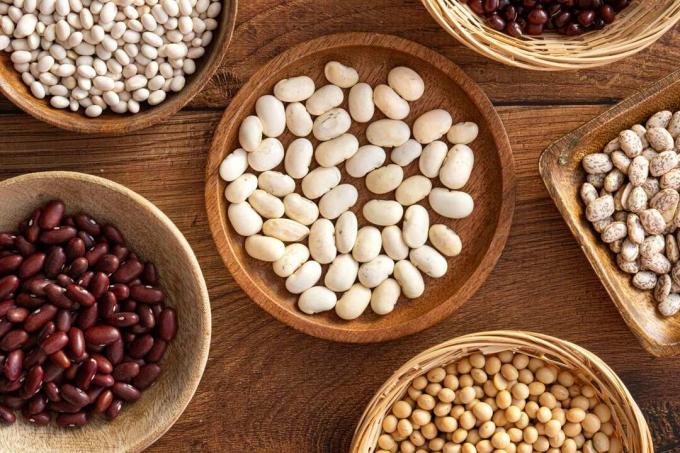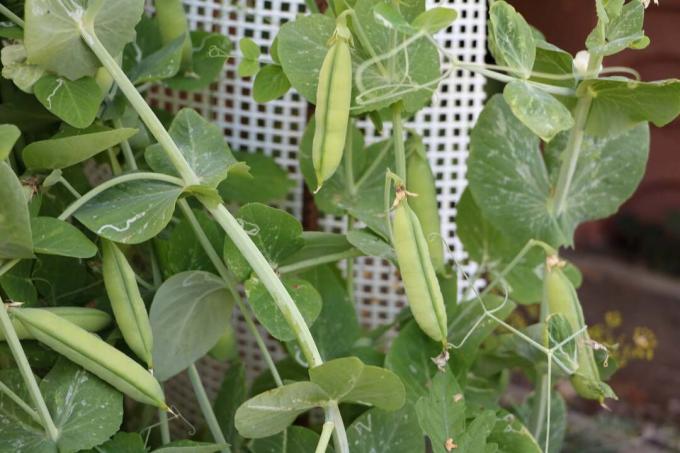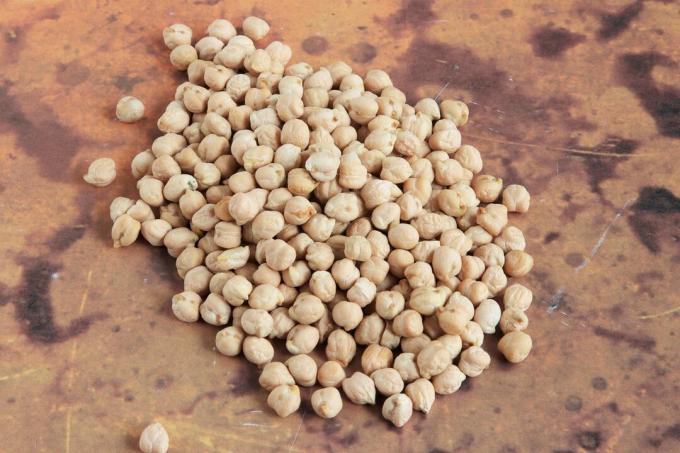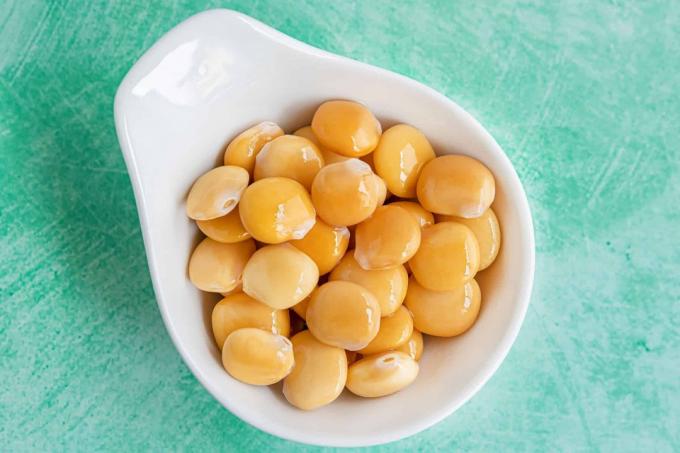
The legume family contains some of the most important staple foods of global importance. They are characterized by a high protein content and are high-yielding on a small area. We present the most important legumes.
In a nutshell
- Legumes as an important vegetable protein source that can serve as a meat substitute
- Beans and peas are easy to grow, regular harvesting possible
- Sweet lupins are particularly rich in protein and require a lot of space to grow
- Lentils are a good substitute for meat, but difficult to grow
- Peanuts among legumes with the highest fat content
Table of contents
- Benefits of legumes
- beans
- Peas
- Chickpeas
- lenses
- soybeans
- sweet lupine
- peanuts
- frequently asked Questions
Benefits of legumes
Beans, lentils or peas had previously played a supporting role on the plates. In many cultures, however, they are one of the most important foods because they are a valuable source of protein. Legumes are particularly important in countries where meat is not available in large quantities.

Advantages at a glance:
- high iron content
- Absorption of iron is through foods with a lot vitamin C favored
- a lot of roughage ensures a quick saturation
- sustainable diet
- require little cultivation area with high yield
- low water requirement in cultivation
- Bacteria in the roots absorb nitrogen from the air and make it available as fertilizer
Tip: Use legumes as a pre-culture for heavy feeder. This allows you to save fertilizer and the root system loosens the soil.
beans

The main legumes that are commonly eaten are beans. However, they are poisonous when raw and must therefore be fully cooked through. The selection of beans is enormous and they can be processed in many ways in the kitchen. Even sweet dishes can be made from it. In Asian cuisine, a paste is made from the adzuki beans, which is sweetened. The beans are grown in bush and pole beans divided. Both variants are now available countless varieties, which have many uses in the kitchen, such as green beans or dry beans.
| calories | protein | carbohydrates | Fat | fiber |
|---|---|---|---|---|
| 33 calories | 22.1g | 63g | 1.2g | 22g |

Beans are easy to grow because they thrive on poor soil. No-till is the easiest way to grow beans in the hobby garden. When growing, you should only make sure that the temperatures are not too low, because beans are very sensitive to frost. From the beginning of May, the ground is warm enough that the beans are no longer threatened.
| Commonly grown bean varieties | |
|---|---|
| pole beans | bush beans |
| - Cowpea – fire bean – bug bean – Lima bean – Runner Bean – Asparagus or meter beans |
– Adzuki bean - Kidney bean – mung bean |
Peas

Land right after the beans Peas as a common vegetable on the plates. A distinction is made between mangetout, marrow and shell peas. snow peas are usually smaller, but can be eaten when young, including the pod. Shell peas ripen in the pod and can even be stored dry. When young, wrinkled peas are edible, including the pod, like mangetout. If they are older, the pod becomes fibrous and the peas are simply removed and eaten, as with shell peas.
| calories | protein | carbohydrates | Fat | fiber |
|---|---|---|---|---|
| 81 calories | 6.4g | 11.4g | 0.4g | 5.2g |

Peas are less sensitive to frost than beans. You can start growing early in the year. An early culture is an advantage because the peas are susceptible to pests. If you start earlier, you can reduce the pest pressure a little.
| Popular pea varieties | ||
|---|---|---|
| snow peas | wrinkled peas | shell peas |
| - Ambrosia – BluePod – Golden Sweet – Oregon Sugar Pod |
- Sima – Wonders of Kelvedon |
– Blauwshokker - Little Rhinelander |
Tip: There are varieties of peas, such as the “Sima” variety, suitable for winter cultivation. Cultivation takes place in late autumn and the small plants easily survive frost and snow in winter.
Chickpeas

Chickpeas are mainly found in oriental cuisine. The most famous dish from it is “hummus”. They are not directly related to peas. The addition in this country is not common, although it is possible in the temperate climate. However, the yields are low, which is why large areas are required in the home garden.
| calories | protein | carbohydrates | Fat | fiber |
|---|---|---|---|---|
| 130 calories | 9g | 17g | 2g | 10g |
lenses

Lentils are an emerging legume because they are often used as a meat substitute. Burger patties can be replaced with lentils, for example. The increases accordingly variety of lenses at. In addition to plate and beluga lentils, there are even special breeds in Europe, such as the Alb lentil, which are optimally adapted to the regional climate.
| calories | protein | carbohydrates | Fat | fiber |
|---|---|---|---|---|
| 260 calories | 27g | 55g | 2.6g | 8g |
Lentils are not suitable as a culture in your own garden. They need a support to hold on to. Lentils are therefore usually grown together with various types of grain. They are harvested together and then separated. The complex harvesting process sometimes leads to high costs when shopping in the supermarket.
| Popular lentil varieties | ||
|---|---|---|
| Albline | beluga lens | mountain lens |
| yellow lens | Green Lens | Red lens |
| Black lens | disc lens |
soybeans

Although soy is rarely found directly on the plate, it is part of many dishes. Soy is best known in coagulated form as tofu. Similar to sugar snap peas, there are also types of soy that are suitable for eating when young, including the pod. The varieties are usually summarized under the term "Edamame".
| calories | protein | carbohydrates | Fat | fiber |
|---|---|---|---|---|
| 250 calories | 37g | 30g | 20g | 9g |
Soybean is easy to grow, but you need larger areas in the garden to harvest significant quantities. A moderate basic fertilization before cultivation with about horn shavings is recommended. Soy is very dominant and weeds hardly stand a chance. This makes it easy to care for and tolerates longer dry periods without any problems.
Tip: In addition to white soy, there are also black soy types. If soy milk or tofu is made from it, it has a slightly purple color.
sweet lupine

The sweet lupine is a legume that is on the rise. It can be used in a variety of ways in the kitchen and is mainly offered ground as a flour substitute for those with gluten intolerance.
| calories | protein | carbohydrates | Fat | fiber |
|---|---|---|---|---|
| 340 calories | 42g | 13g | 6g | 38.4g |
Sweet lupins were already an important source of food during the Egyptian civilization. Even Hildegard von Bingen appreciated the protein-rich legume. All you have to do when growing it is to give it a sunny spot. They also need a lot of space, but deliver a lot of yield. For a plant you need to plan an average space of 50×50 cm.
A notice: When buying the seeds, make sure that they are edible lupins. There are lupins also as ornamental plants, however, they are poisonous.
peanuts

Peanuts are part of many nut mixes and are high in fat. Botanically, the peanut is exciting because the fertilized flowers grow into the ground, where the fruits then ripen. Another special feature of the peanut is that although it has a nut fruit, since its pod is Maturation does not open independently, but due to their optical characteristics they still belong to the legumes heard.
| calories | protein | carbohydrates | Fat | fiber |
|---|---|---|---|---|
| 600 calories | 25.3g | 16g | 48.1g | 9g |
The main growing areas of peanuts located in America, Africa and India. However, the peanut can be grown here with a good yield. It takes 200 days from seed to fruit maturity, so cultivation is only possible with an early preculture or in a sheltered greenhouse.
Compared to other legumes, the peanut benefits from good basic fertilization. The ground should always be kept clear so that the flowers are not prevented from growing into the ground by weeds.
A notice: The nutritional values given in the text are average values and refer partly to the fresh form, partly to the dry or cooked form.
frequently asked Questions
Peas are one of the healthiest legumes. They are very high in protein. In addition, varieties such as sugar snap peas that can be eaten with the pods young have a high fiber content. Chickpeas are also healthy. In addition to protein, chickpeas are rich in vitamins and trace elements.
Legumes can be incorporated into the daily diet in a wide variety of ways. Anyone who has only eaten a little of it should slowly increase the amounts so that the digestion can adjust. If you also season the dishes with legumes with spices such as caraway or ginger, this promotes digestion.
Legumes can be part of any meal. However, if you have problems with gout or elevated uric acid levels, you should only consume a small amount of it. This is because legumes contain purine, which can build up in the joints, leading to gout or high levels of uric acid.


